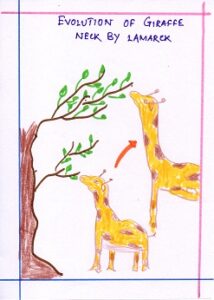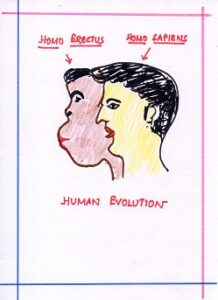EVOLUTION NOTES
INTRODUCTION:
Human beings have always been perplexed about the origin and evolution of life on earth. For centuries, a number of theories and hypothesis have been suggested to explain the evolutionary process.
In the previous year, in a very short time life was created by some supernatural power. Most of the religions and civilizations still believe in it, however, they do not have a scientific explanation and more a matter of faith. There has always been an attempt by the scientists and naturalists with keen observation, to explain the evolution scientifically and to look for its evidences.
The process of evolution involves a gradual change or variation in the organisms generation after generation. It means that the organisms of present-day have arisen from ancestors that were simpler in an organisation.
CAUSES: The following are causes of evolution.
- Variation in the gene pool of members of a population.
- Natural selection favouring the accumulation of advantageous variations.
- Genetic drift or chance selection.
The word evolution has been derived from the Latin word “evolvere” (e: out, Volvo: to roll) means to unroll or unfold to reveal modifications or gradual changes. Therefore, evolution is defined as a naturally occurring slow, continuous and irreversible process of change.
THEORIES OF EVOLUTION: From time to time, several theories have been put forth to explain the process of evolution of plants and animals. Some of these theories are described here.
LAMARCK’S THEORY OF EVOLUTION:
THEORY OF INHERITANCE OF ACQUIRED CHARACTER
One of the first attempts to explain evolution was made by the French Biologist Lamarck in 1809. Lamarck published his work in a book called “Philosophic Zoologique”. The theory proposed by Lamarck is known as the “Theory of inheritance of acquired characters” or “Lamarckism”.
TWO ASSUMPTIONS OF HIS THEORY:
- USE AND DISUSE OF THE ORGANS OR BODY PARTS:
The organs or body parts of the body which are used more and more, become elongated or increase in size while the parts that are not used to become weak and smaller and gradually disappear.
- INHERITANCE OF ACQUIRED CHARACTERS: The characteristics or changes acquired during the life time of an organism are transmitted by heredity to the next generation (offspring).
Lamarck believed that new species evolved after a long period of time, after many generations acquiring new characters and losing the old characters (depending on the use and disuse of organs).
EXAMPLES TO SUPPORT LAMARCKISM:
- Lamarck took the examples of giraffe in support of his theory.

- According to Lamarck, there was a time when giraffes were short necked.
- When these short necked giraffe did not find any vegetation to feed on the ground, they tried to reach the upper part of a tree to eat its leaves.
- Thus by making continuous efforts, the neck and forelimbs of giraffe started becoming the longer gradually.
- These acquired characters were inherited by the offsprings of the giraffe in successive generations.
- After a considerable long period of time, the giraffe evolved having a long neck and longer forelimbs than hind limbs.
This proves an effect of extra use and lengthening of some organs.
- Vestigial organs refer to the organ structures that have lost all or most of its original function present in another species, generally present in rudimentary conditions.
Wisdom teeth and pinnae are other examples of vestigial organs.
EXPERIMENTS BY WEISMANN
Weismann in nineteenth century tested the Lamarck’s theory by cutting off the tails of mice generation after generation. According to Lamarck’s theory, the subsequent generation should have had the shorted tails but in Weismann experiments the offsprings of mice whose tails were cut had the tails of the same length.
Weismann continued his experiment for 20 generation but found mice with tails of the same length as the first generation. He discarded the theory of inheritance of acquired character.
DARWIN’S THEORY OF EVOLUTION BY NATURAL SELCTION.
Charles Darwin, an English naturalist and biologist is well known for his work as a naturalist and his theory on evolution.
He sailed on a survey ship called “HMS Beagle” in 1831 at the young age of 22 years and explored South America, the Galapagos Islands and other islands in next five years. During this time he studied variety of animals and collected a great deal of data on variation.
Based on his data, in 1839 Darwin formulated his theory popularly known as “Theory of Natural Selection” and published his book “The origin of species”.
DARWIN’S THEORY OF EVOLUTION ( EVOLUTION DEFINITION )
Darwin’s theory of evolution by natural selection can be summarized below:
- OVERPRODUCTION: All the organisms produce much more offspring than can actually survive. For example, a housefly lays thousands of eggs, a fern plant produces millions of spores etc.
- STRUGGLE FOR EXISTANCE: Due to over production, there must be a struggle for existence. There is struggle between the member of same species for food, water, air and other space. Only a few are able to survive and rest perish or get eliminated.
- VARIATIONS EXIST WITHIN A POPULATION: The offsprings of the same parents differ from one another and show variations. Apart from the visible variations, certain hidden variation also exists.
- SURVIVAL OF THE FITTEST OR NATURAL SELECTION: The individuals with favourable variations survive in the struggle. The organisms with unfavourable variations die out and only the fittest individuals survive, reproduce and pass their favourable characters to the next generation.

The process of survival of the fittest over many generations slowly increases the proportion of fit individuals due to heritable favourable variations.
In other words, nature selects the individuals that are well adapted to the environment and allows them to survive. At the same time, nature reflects those, which are poorly developed. Hence natural selection is weeding out the process by which only the fittest individual is selected.
- ORIGIN OF NEW SPECIES: As the favourable variations of the fittest animals are inherited to the offsprings, these variations accumulated over the generations. After several generations, the organisms become so different from the original species that they lead to the origin of new species.
EXAMPLES TO SUPPORT THEORY OF NATURAL SELECTION
The case of the peppered moth in England is the most frequently discussed example of natural selection. This refers to an increase in the number of dark coloured moths due to increased industrial pollution. This is also referred as industrial melanism.
- Before the industrial revolution, dark coloured moths were hardly known. The light coloured species were adapted to rest during the day on lichen coloured trunks of trees.
- But due to increase in sulphur dioxide in air because of the industries, the lichens started to reduce on tree trunks, exposing darker bark which was further darkened by falling smoke particles.
- Now the light coloured species become conspicuous and attracted its predators.
- For the survival of moths, nature produced a mutation leading to dark coloured moth species from light coloured species.
- Within a period of few years, the industrial or polluted areas saw that the dark species had almost replaced the light species. Through this, moth showed natural selection at work.
MODERN THEORY OF EVOLUTION
It is the most accepted theory of evolution now. According to this theory called neo Darwinism, the origin of species is based on :
- The interaction of genetic variation.
- Natural selection.
It incorporates the knowledge of genetics with the basic structure of Darwin’s theory.
This theory takes into account evidences from genetic, molecular biology, fossils, ecology etc.
It takes into account the charges that may arise due to the accumulation of mutations in a population.